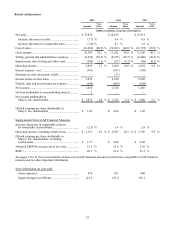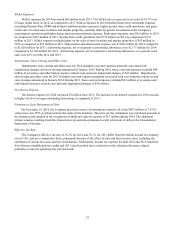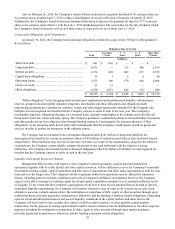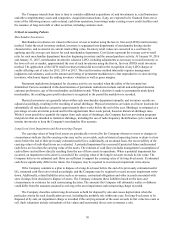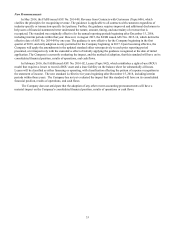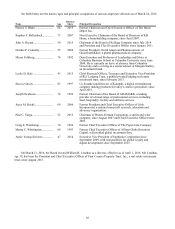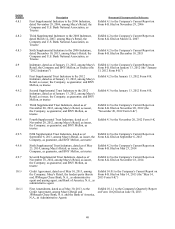Macy's 2015 Annual Report Download - page 35
Download and view the complete annual report
Please find page 35 of the 2015 Macy's annual report below. You can navigate through the pages in the report by either clicking on the pages listed below, or by using the keyword search tool below to find specific information within the annual report.30
The Company intends from time to time to consider additional acquisitions of, and investments in, retail businesses
and other complementary assets and companies. Acquisition transactions, if any, are expected to be financed from one or
more of the following sources: cash on hand, cash from operations, borrowings under existing or new credit facilities and
the issuance of long-term debt or other securities, including common stock.
Critical Accounting Policies
Merchandise Inventories
Merchandise inventories are valued at the lower of cost or market using the last-in, first-out (LIFO) retail inventory
method. Under the retail inventory method, inventory is segregated into departments of merchandise having similar
characteristics, and is stated at its current retail selling value. Inventory retail values are converted to a cost basis by
applying specific average cost factors for each merchandise department. Cost factors represent the average cost-to-retail
ratio for each merchandise department based on beginning inventory and the annual purchase activity. At January 30, 2016
and January 31, 2015, merchandise inventories valued at LIFO, including adjustments as necessary to record inventory at
the lower of cost or market, approximated the cost of such inventories using the first-in, first-out (FIFO) retail inventory
method. The application of the LIFO retail inventory method did not result in the recognition of any LIFO charges or
credits affecting cost of sales for 2015, 2014 or 2013. The retail inventory method inherently requires management
judgments and estimates, such as the amount and timing of permanent markdowns to clear unproductive or slow-moving
inventory, which may impact the ending inventory valuation as well as gross margins.
Permanent markdowns designated for clearance activity are recorded when the utility of the inventory has
diminished. Factors considered in the determination of permanent markdowns include current and anticipated demand,
customer preferences, age of the merchandise and fashion trends. When a decision is made to permanently mark down
merchandise, the resulting gross profit reduction is recognized in the period the markdown is recorded.
Physical inventories are generally taken within each merchandise department annually, and inventory records are
adjusted accordingly, resulting in the recording of actual shrinkage. Physical inventories are taken at all store locations for
substantially all merchandise categories approximately three weeks before the end of the year. Shrinkage is estimated as a
percentage of sales at interim periods and for this approximate three-week period, based on historical shrinkage rates.
While it is not possible to quantify the impact from each cause of shrinkage, the Company has loss prevention programs
and policies that are intended to minimize shrinkage, including the use of radio frequency identification cycle counts and
interim inventories to keep the Company's merchandise files accurate.
Long-Lived Asset Impairment and Restructuring Charges
The carrying values of long-lived assets are periodically reviewed by the Company whenever events or changes in
circumstances indicate that the carrying value may not be recoverable, such as historical operating losses or plans to close
stores before the end of their previously estimated useful lives. Additionally, on an annual basis, the recoverability of the
carrying values of individual stores are evaluated. A potential impairment has occurred if projected future undiscounted
cash flows are less than the carrying value of the assets. The estimate of cash flows includes management's assumptions of
cash inflows and outflows directly resulting from the use of those assets in operations. When a potential impairment has
occurred, an impairment write-down is recorded if the carrying value of the long-lived asset exceeds its fair value. The
Company believes its estimated cash flows are sufficient to support the carrying value of its long-lived assets. If estimated
cash flows significantly differ in the future, the Company may be required to record asset impairment write-downs.
If the Company commits to a plan to dispose of a long-lived asset before the end of its previously estimated useful
life, estimated cash flows are revised accordingly, and the Company may be required to record an asset impairment write-
down. Additionally, related liabilities arise such as severance, contractual obligations and other accruals associated with
store closings from decisions to dispose of assets. The Company estimates these liabilities based on the facts and
circumstances in existence for each restructuring decision. The amounts the Company will ultimately realize or disburse
could differ from the amounts assumed in arriving at the asset impairment and restructuring charge recorded.
The Company classifies certain long-lived assets as held for disposal by sale and ceases depreciation when the
particular criteria for such classification are met, including the probable sale within one year. For long-lived assets to be
disposed of by sale, an impairment charge is recorded if the carrying amount of the asset exceeds its fair value less costs to
sell. Such valuations include estimations of fair values and incremental direct costs to transact a sale.




